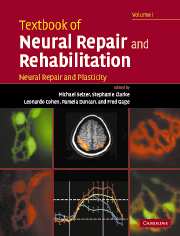Book contents
- Frontmatter
- Contents
- Contents (contents of Volume II)
- Preface
- Contributors (contributors of Volume I)
- Contributors (contributors of Volume II)
- Neural repair and rehabilitation: an introduction
- Section A Neural plasticity
- Section A1 Cellular and molecular mechanisms of neural plasticity
- Section A2 Functional plasticity in CNS system
- Section A3 Plasticity after injury to the CNS
- Section B1 Neural repair
- 16 Neuronal death and rescue: neurotrophic factors and anti-apoptotic mechanisms
- 17 Axon degeneration and rescue
- 18 Adult neurogenesis and neural precursors, progenitors, and stem cells in the adult CNS
- 19 Axon guidance during development and regeneration
- 20 Synaptogenesis
- Section B2 Determinants of regeneration in the injured nervous system
- Section B3 Promotion of regeneration in the injured nervous system
- Section B4 Translational research: application to human neural injury
- Index
19 - Axon guidance during development and regeneration
from Section B1 - Neural repair
Published online by Cambridge University Press: 05 March 2012
- Frontmatter
- Contents
- Contents (contents of Volume II)
- Preface
- Contributors (contributors of Volume I)
- Contributors (contributors of Volume II)
- Neural repair and rehabilitation: an introduction
- Section A Neural plasticity
- Section A1 Cellular and molecular mechanisms of neural plasticity
- Section A2 Functional plasticity in CNS system
- Section A3 Plasticity after injury to the CNS
- Section B1 Neural repair
- 16 Neuronal death and rescue: neurotrophic factors and anti-apoptotic mechanisms
- 17 Axon degeneration and rescue
- 18 Adult neurogenesis and neural precursors, progenitors, and stem cells in the adult CNS
- 19 Axon guidance during development and regeneration
- 20 Synaptogenesis
- Section B2 Determinants of regeneration in the injured nervous system
- Section B3 Promotion of regeneration in the injured nervous system
- Section B4 Translational research: application to human neural injury
- Index
Summary
During neural development, many neurons must extend an axon across a relatively large distance in order to reach their targets and make appropriate synaptic connections. Several models were contemplated during the 20th century to explain axon guidance. Late in the 19th century, Santiago Ramón y Cajal proposed a chemotropic model (Ramón y Cajal, 1892), speculating that axons reach their targets by sensing molecular cues. Later, based on observations of live neurons in cell culture, Ross Granville Harrison and Paul Weiss put forth a stereotropic model, proposing a form of mechanical guidance whereby axons respond to relatively nonspecific physical constraints. This was inspired by finding that axons tend to follow mechanical discontinuities on a substrate, such as scratches on the bottom of a glass cell culture dish (Harrison, 1914; Weiss, 1934). Paul Weiss elaborated on this model by proposing the resonance principle, which argues that a rough layout of neuronal connections established by stereotropism is subsequently refined by matching an axon's electrical activity with that of its target (Weiss, 1941). It was not until the early 1940s that Roger Sperry, a student of Paul Weiss, revived the hypothesis that chemical cues direct axon growth by demonstrating that axons regenerating along the frog optic nerve reconnect with their original targets in the tectum (reviewed in Sperry, 1963).
Keywords
- Type
- Chapter
- Information
- Textbook of Neural Repair and Rehabilitation , pp. 326 - 345Publisher: Cambridge University PressPrint publication year: 2006
- 5
- Cited by



